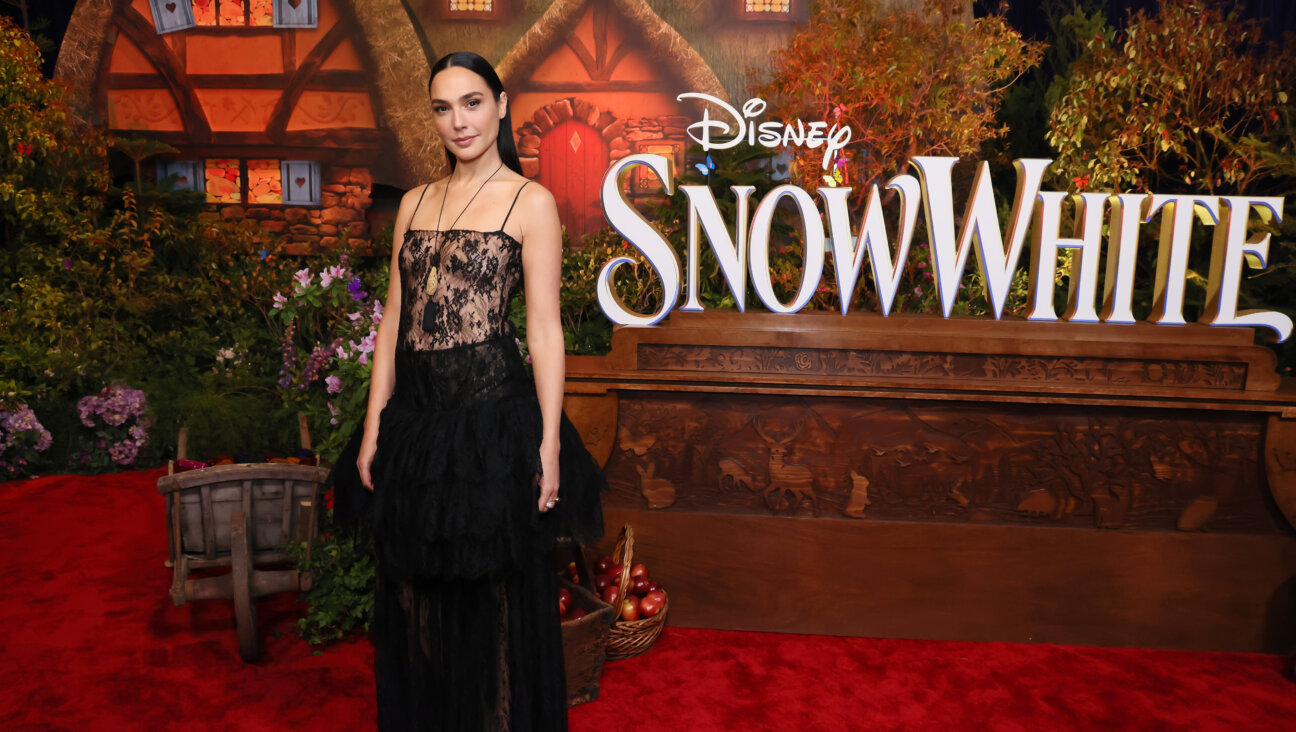Your Trash, Her Treasure

Mixed Media: The artist Jo Milgrom in 1994, at work on a piece. Below: ?Marilyn Gets Religion,? left, and a manual typewriter-turned-mezuzah.
On a recent afternoon, Jacob Milgrom pored over the Book of Ezekiel in his Jerusalem study. The 86-year-old, one of the foremost biblical scholars alive today, took slow breaths and carefully marked the Hebrew text in pencil.

Mixed Media: The artist Jo Milgrom in 1994, at work on a piece. Below: ?Marilyn Gets Religion,? left, and a manual typewriter-turned-mezuzah.
On the opposite side of the house was his 80-year-old wife, Jo Milgrom. She, too, was pondering biblical meaning. In her hands, though, were long, punched strips of old printer paper. “It’s like paper lace,” Milgrom said. “I saw this at the printer’s and said, ‘Don’t throw it out, it’s beautiful.’” Milgrom wanted to set up a fan so that the paper strips would float in the air — a depiction of God’s hovering spirit from the Genesis story of creation.
This is not arts and crafts hobbyism: Milgrom is an assemblage artist. She calls her work “visual midrash,” referencing the Jewish literary tradition of supplementing the biblical narrative with commentary, often in the form of colorful homilies. Traditional midrash was written from the third to the 12th centuries, but Milgrom believes there’s just as much of a place for creative midrash today as there is for the kind of scholarly interpretations her husband writes. She’ll promote artistic approaches to the Bible on May 16 at Temple Israel Center in White Plains, N.Y., when she gives an interactive lesson titled “Through the Looking Glass at Mount Sinai.” And next month, the TALI Education Fund in Israel will launch an online image database of more than 2,000 biblical- and Judaic-themed artworks, collected by Milgrom over several decades.
“Jo’s work is indispensable,” said Jacob, whose Ezekiel commentary is forthcoming in the Anchor Bible series. “He’s the left brain, and I’m the right brain,” Milgrom added. She went on to quote Elie Wiesel: “Midrash is to Bible as imagination is to knowledge.”
It takes imagination to see Jewish meaning in junk. But that’s exactly what makes up Milgroms’s artistic pallet. Suitcases, antique bars of soap, dental models, Scrabble pieces, old bras — she snaps up these items around the neighborhood, in Dumpsters and at secondhand shops. She would be considered a Dumpster diver in any other place, but in Jerusalem, a city layered with history, she’s more of an archaeologist. Milgrom unearths objects, imbues them with meaning and displays the treasures. Once, she came away from a Jewish funeral home with bundles of tefillin and torn tallitim slated for burial. “You can trust me to give a new life to these objects that aren’t usable in the traditional religious sense,” she told the funeral home’s director.
The assembled objects end up on every wall, table and doorpost of the Milgroms’ home, an Arab residence built in 1929 and used as a British soldiers’ club during World War II. The couple settled in upon their move to Israel from Berkeley, Calif., in 1994. Their house now doubles as Milgrom’s art gallery.
“We’re starting in the bedroom. I don’t usually do this on the first date,” Milgrom joked as she gave a tour. On the mantle opposite the bed is an upside-down tallit bag, cupped inside a bra. Its title is an adaptation of verses from the Song of Songs: “I am my beloved’s, and my beloved is mine; between my breasts he lies.” Why the inverted tallit bag? Milgrom’s matter-of-fact response: “Love is not bound by traditional orders.”
Neither is most of her art. Her mezuzas aren’t like any you’d find in a Judaica shop. One is an old manual typewriter with the rolled-up klaf *(parchment) peeking out. “[The Bible] says ‘write them on the doorposts of your house.’ Someone conveniently threw out a typewriter. You think I would pass that up?” Milgrom said with a grin. On the Milgroms’ front doorpost is a jumbo-sized mezuza with a triangle-shaped hazard reflector — the kind found in the glove compartments of Israelis’ cars — reassembled to form the Hebrew letter *shin that adorns traditional mezuzas. This mezuza was made from a row of apartment-building mailboxes. “Messages being sent and received,” Milgrom explained. There’s plenty of humor in these mezuzas, but she relates to them with the utmost spiritual gravitas: “They’re a response to those tiny things that people put on the doorpost and pass without much attention. It’s the axis mundi connection with God. The idea of stopping at the threshold, where time and space meet. That’s the sanctified moment. It’s a gesture. When it’s conscious, it’s very powerful.”
Milgrom didn’t begin to make art until she hit 60. She taught Judaism and art at the Graduate Theological Union in Berkeley, and received a doctorate from the same institution in 1978. Later, she authored “Handmade Midrash: Workshops in Visual Theology” (Jewish Publication Society, 1992), a guide for teaching Bible through simple art projects. Meanwhile, she had accumulated junk in the garage but didn’t know what to do with it. So she approached Nancy Chinn, a California-based Catholic artist whose religious-themed works are displayed in churches. “I remember being struck with fear,” Chinn said. “She was asking me to teach her how to make art. I said, ‘Jo, I don’t think I can do this.’” But Milgrom insisted. Looking back, Milgrom said that Chinn “midwifed” her first assemblages. Today, Milgrom collaborates with Jerusalem artist Elisheva Yortner. Both Chinn and Yortner used the same word to describe Milgrom: adventurous.
Milgrom’s mixed-media art packs in unflinching commentaries on biblical narratives, spirituality, creativity, gender and politics. Her unorthodox approach to religious art may have found a welcoming home in Berkeley, but in the conservative capital of the Jewish people, exhibiting this stuff takes guts. “How dare you use these ritual objects in such a sacrilegious way?” was the gist of some visitors’ comments at New Things and Old, Beloved, Milgrom’s 2007 exhibition at the Jerusalem Theater. (Does Jewish law forbid the artistic recycling of ritual objects? “There is enough ambiguity that it works in my favor,” Milgrom said.) Noga Arad-Ayalon, the Jerusalem Theater art curator, recalled Milgrom’s piece “Marilyn Gets Religion,” in which Monroe dons tzitzit. “A person needs a lot of bravery to hang that up on the wall and to say, this is my truth,” Arad-Ayalon said. “That’s what amazed me about her art. Jo isn’t interested in making anyone feel good.”
Daniel Estrin is a print and radio journalist. He has contributed to USA Today, Nextbook, and the public radio programs “Marketplace” and “The World.”
The Forward is free to read, but it isn’t free to produce

I hope you appreciated this article. Before you go, I’d like to ask you to please support the Forward.
At a time when other newsrooms are closing or cutting back, the Forward has removed its paywall and invested additional resources to report on the ground from Israel and around the U.S. on the impact of the war, rising antisemitism and polarized discourse.
Readers like you make it all possible. We’ve started our Passover Fundraising Drive, and we need 1,800 readers like you to step up to support the Forward by April 21. Members of the Forward board are even matching the first 1,000 gifts, up to $70,000.
This is a great time to support independent Jewish journalism, because every dollar goes twice as far.
— Rachel Fishman Feddersen, Publisher and CEO






















